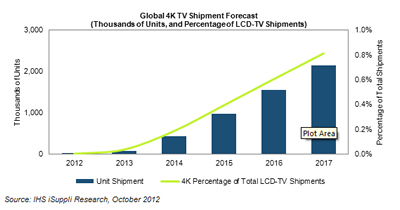4K TV adoption to be slow, says IHS iSuppli
Consumer demand for televisions with the ultra-high-definition 4K resolution will remain negligible for the foreseeable future, with shipments not accounting for more than 1 percent of the global liquid crystal display (LCD) TV market over the next five years.
Those are among the conclusions of the market research firm “IHS iSuppli Television Market Tracker Report.” According to the report, worldwide shipments of 4K LCD-TVs will grow from 4000 this year to 2.1 million units in 2017. Despite the large increase over the years, 4K will account for only 0.8 percent of the global LCD-TV shipments by 2017. This new generation of ultra-high-definition televisions is known as 4K because it offers four times the pixels of high definition, 3840 by 2160 pixels vs. 1920 by 1080 pixels

The 4K television segment recently has garnered attention with Japanese manufacturer Sony announcing an 84in 4K LCD-TV priced at $25,000. LG Electronics of South Korea also launched an 84in LCD-TV for $20,000. Japan’s Toshiba is offering a 55in model priced at $10,000.
Chinese brands Hisense and Konka announced that they will launch 84in 4K sets this year. However, IHS thinks that neither consumers nor television brands will have the interest required to make the 4K LCD-TV market successful.
“If you have a television that is 60ins or larger and are watching video that has a 3840 by 2160 resolution, then a 4K television makes sense,” said Tom Morrod, director, TV systems and technology research for IHS.
“However, a very limited amount of content is available at the 4K resolution. Meanwhile, because of high prices and other issues, the market for super-sized, 60in and larger sets is very small, at only about 1.5 percent of total television shipments in 2012. Furthermore, for most people, the 1080p resolution is good enough. Because of these factors, combined with the massive price tags, the market for 4K sets during the next few years will be limited to very wealthy consumers or to commercial uses.”
The professional video industry's #1 source for news, trends and product and tech information. Sign up below.
